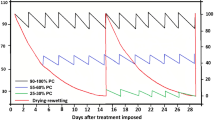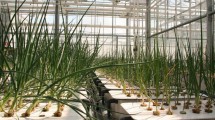Abstract
Main conclusion
Theoretical derivation predicted growth retardation due to pot water limitations, i.e., pot binding. Experimental observations were consistent with these limitations. Combined, these results indicate a need for caution in high-throughput screening and phenotyping.
Pot experiments are a mainstay in many plant studies, including the current emphasis on developing high-throughput, phenotyping systems. Pot studies can be vulnerable to decreased physiological activity of the plants particularly when pot volume is small, i.e., “pot binding”. It is necessary to understand the conditions under which pot binding may exist to avoid the confounding influence of pot binding in interpreting experimental results. In this paper, a derivation is offered that gives well-defined conditions for the occurrence of pot binding based on restricted water availability. These results showed that not only are pot volume and plant size important variables, but the potting media is critical. Artificial potting mixtures used in many studies, including many high-throughput phenotyping systems, are particularly susceptible to the confounding influences of pot binding. Experimental studies for several crop species are presented that clearly show the existence of thresholds of plant leaf area at which various pot sizes and potting media result in the induction of pot binding even though there may be no immediate, visual plant symptoms. The derivation and experimental results showed that pot binding can readily occur in plant experiments if care is not given to have sufficiently large pots, suitable potting media, and maintenance of pot water status. Clear guidelines are provided for avoiding the confounding effects of water-limited pot binding in studying plant phenotype.



Similar content being viewed by others
References
Bourgault M, James AT, Dreccer MF (2017) Pot size matters revisited: does container size affect the response to elevated CO2 and our ability to detect genotypic variability in this response in wheat? Func Plant Biol (currently online, 8 Dec 2016)
Dambreville A, Griolet M, Rolland G, Dauzat M, Bediee A, Balsera C, Muller B, Vile D, Granier C (2017) Phenotyping oilseed rape growth—related traits and their responses to water deficit: the disturbing pot size effect. Func Plant Biol (currently online, 8 Dec 2016)
Devi MJ, Sinclair TR, Beebe SE, Rao IM (2013) Comparison of common bean (Phaseolus vulgaris L.) genotypes for nitrogen fixation tolerance to soil drying. Plant Soil 364:29–37
Gholipoor M, Sinclair TR, Raza MAS, Loffler C, Cooper M, Messina CD (2013) Maize hybrid variability for transpiration decrease with progressive soil drying. J Agron Crop Sci 199:23–29
Hess L, De Kroon H (2007) Effects of rooting volume and nutrient availability as an alternative explanation for root self/non-self discrimination. J Ecol 95:241–251
Ismail AM, Hall AE, Bray EA (1994) Drought and pot size effects on transpiration efficiency and carbon isotope discrimination of cowpea accessions and hybrids. Aus J Plant Phyisol 21:23–35
Kasai M, Koide K, Ichidawa Y (2012) Effect of pot size on various characteristics related to photosynthetic matter production in soybean plant. Int J Agron 7, #751731
Manandhar A, Sinclair TR, Rufty TW, Ghanem ME (2016) Leaf expansion and transpiration response to soil drying and recovery among cowpea genotypes. Crop Sci (in reviews)
NeSmith DS, Duval JR (1998) The effect of container size. Hortech 8:495–498
Poorter H, Buhler J, van Dusschoten D, Climent J, Postma JA (2012) Pot size matters: a meta-analysis of the effects of rooting volume on plant growth. Func Plant Biol 39:839–850
Ratliff LF, Ritchie JT, Cassel DK (1983) Field-measured limits of soil water availability as related to laboratory-measured properties. Soil Sci Soc Am J 47:770–775
Ray JD, Sinclair TR (1998) The effect of pot size on growth and transpiration of maize and soybean during water deficit stress. J Exp Bot 49:1381–1386
Ronchi CP, DaMatta FM, Batista KD, Moraes GABK, Loureiro ME, Ducatti C (2006) Growth and photosynthetic down-regulation in Coffea arabica in response to restricted root volume. Func Plant Biol 33:1013–1023
Sadras VO, Milroy SP (1996) Soil-water thresholds for the responses of leaf expansion and gas exchange: a review. Field Crops Res 47:253–266
Sinclair TR, Hammond LC, Harrison J (1998) Extractable soil water and transpiration rate of soybean on sandy soil. Agron J 90:363–368
Sinclair TR, Manandhar A, Belko N, Riar M, Vadez V, Roberts PA (2015) Variation among cowpea genotypes in sensitivity of transpiration rate and symbiotic nitrogen fixation to soil drying. Crop Sci 55:2270–2275
Wahbi A, Sinclair TR (2007) Transpiration response of abrabidopsis, maize, and soybean to drying of artificial and mineral soil. Env Exp Bot 59:188–192
Author information
Authors and Affiliations
Corresponding author
Rights and permissions
About this article
Cite this article
Sinclair, T.R., Manandhar, A., Shekoofa, A. et al. Pot binding as a variable confounding plant phenotype: theoretical derivation and experimental observations. Planta 245, 729–735 (2017). https://doi.org/10.1007/s00425-016-2641-0
Received:
Accepted:
Published:
Issue Date:
DOI: https://doi.org/10.1007/s00425-016-2641-0




